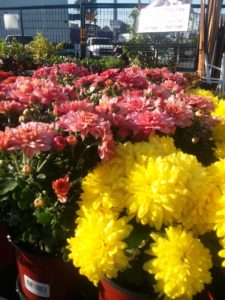
Looking to plant a garden in November, but feeling a little daunted by it all? Read on:
In California, there are two flowers that we most associate with November. One is the ubiquitous chrysanthemum which is in abundant glory in every nursery (including ours). This flower is the official flower of November and with good reason. Chrysanthemums symbolize hope in the darkness, as they are in full bloom during the time of the year when the nights are approaching their longest.
The other flower we see suddenly pop up in California (or at least in our part) is the Marigold. You will see these outside most bodegas and mercados. This flower is also in full bloom around the dark time of the year, just not here. Native to the fields of Mexico, marigolds have long been associated with the dead. In fact, there is evidence of Aztec usage of the flowers in rituals dating back hundreds of years, and now they are the flower most commonly associated with Los Dias de Los Muertos.
The thing is most gardeners will tell you if a flower is in full bloom you are too late if you want to plant it outside. If you buy chrysanthemums or marigolds now, buy them with a lot of closed buds, and pot them so you can keep them in a warmer spot. You will also need to use a good soil and feed them to help encourage root growth. We love these fall flowers and think that they are totally worth the effort. However, what if you want to take advantage of our Mediterranean climate and actually plant in your garden? Lucky for us, we live in California.
First of all, some basic terminology. You will see a lot of advice on fall and winter gardens. Most of that advice is not for beginner gardeners as most beginners don’t get the planting bug this late in the year. So let’s simplify, the first thing you need to know is what zone you are in.
Zones are simply a handy way to make sure that a plant has a good chance of making it when you follow the best growing recommendations for it. There are 3 main list of zones in the U.S. First is the USDA which breaks the entire country down into just 11 growing zones. Obviously, those of us from the Bay area, with our multitude of microclimates, will immediately understand why this classification is too broad. (In general, we are in zone 9)
The USDA also has a subzone list that divides its 11 zones into 20. In this case, we are 9a and the Pt. Reyes peninsula is a 6b. But the zone guide most used by western gardeners is the Sunset zone guide. This has 24 zones for the Western United States of which 20 different zones are found in California.
Since this blog is specifically for the Northern California Bay Area we are going to make it easy for you. We are in zones 15 (Petaluma and the East Bay), 16 (San Rafael, Terra Linda, Marinwood), and 17(Pt. Reyes, and San Francisco). Which zone depends on how close to the bay you are versus how close to the ocean, and if you live in one of the many valleys in our area which keeps you a little warmer.
Okay, now we have our zone what can we plant in a November garden? More than you might think. Now is the time for Zones 15-17 to sow beets, carrots, chard, radishes, and parsley. Plus plant seedlings of cabbage, cauliflower, broccoli, and lettuce. Yes, you can plant an entire garden salad in November!
If you are looking for flowers, now is the time to sow sweet peas, alyssum, and spring wildflowers. If you want to work with seedlings try primrose and snapdragons.
The second thing that most blogs will assume is that you know the difference between sow and plant. You will see that we even used that terminology above. Sow simply means that you are planting seeds directly into the ground. Usually, when we say to sow something, you are either going to scatter the seeds into a specific area or create a furrow to put the seeds in. Generally, when we say planting we are talking about seedlings, in that case, you would dig an individual hole for the plant that has germinated somewhere else (usually a greenhouse or nursery). Some plants are easier to start as seedlings (like broccoli), some it doesn’t matter (strawberries), and some it’s best to start from seeds (carrots). If you want some more advice on which is which check out this great Sunset page that will answer questions more succinctly than we ever could.
These, of course, are merely suggestions, and if you are more advanced at gardening you can always try out more exotics. If you are a beginner stop by the store and let us know what you are trying to do. We have lots of easy plants that will build your confidence so that next year you can have an overflowing November garden and be the envy of the neighborhood.
Now if you’ll excuse us we need to go buy Chrysanthemums and Marigolds.

